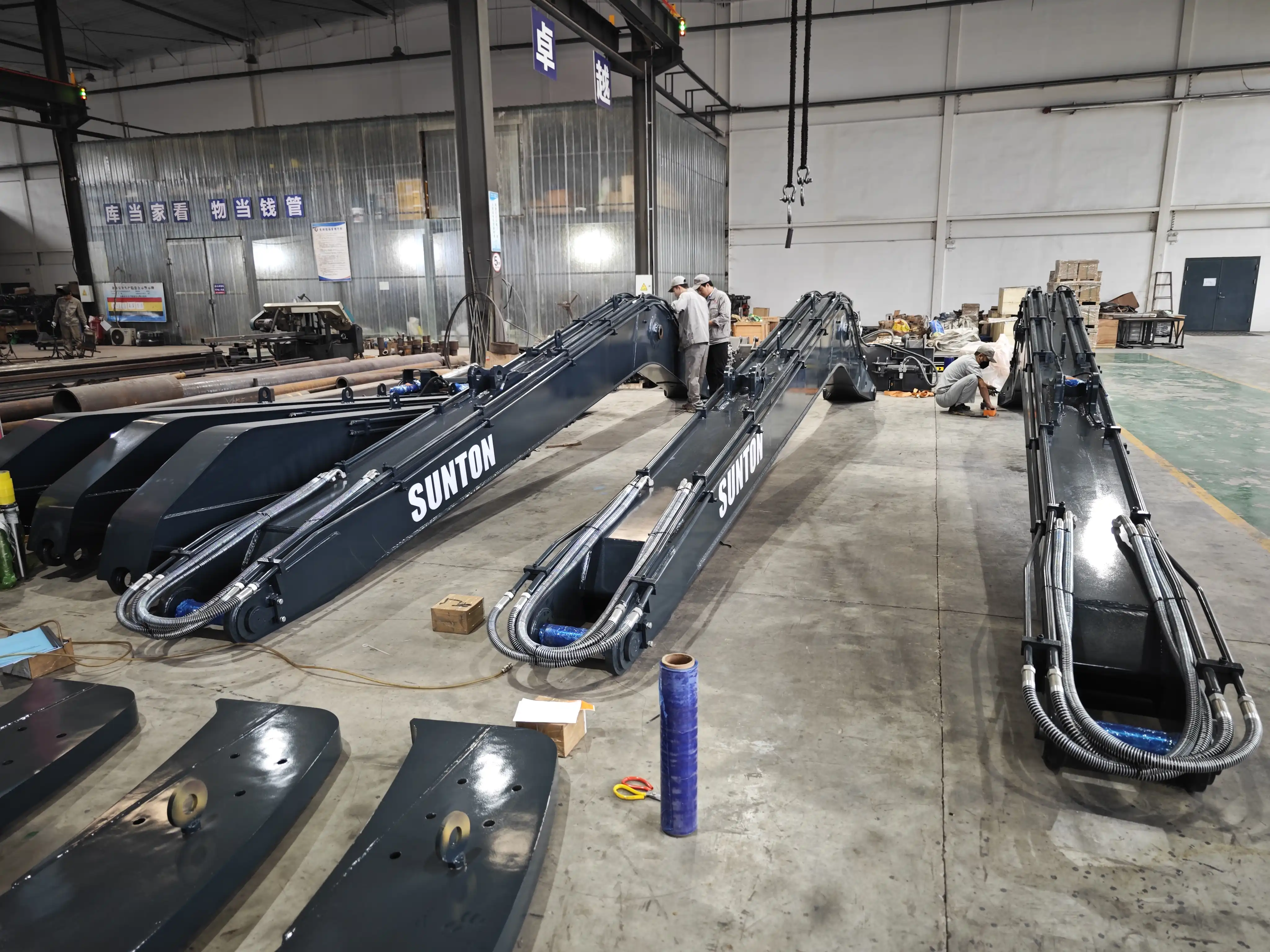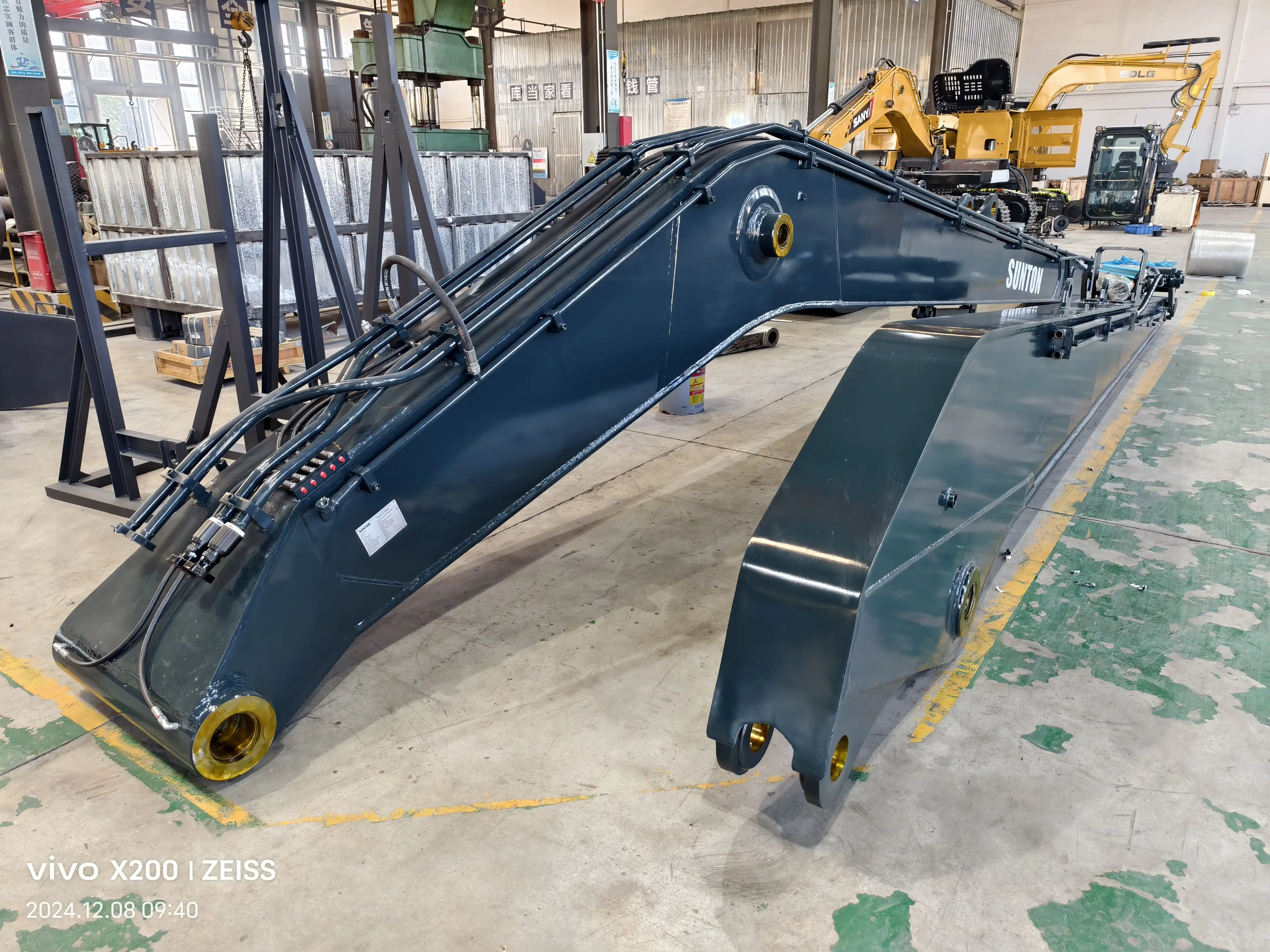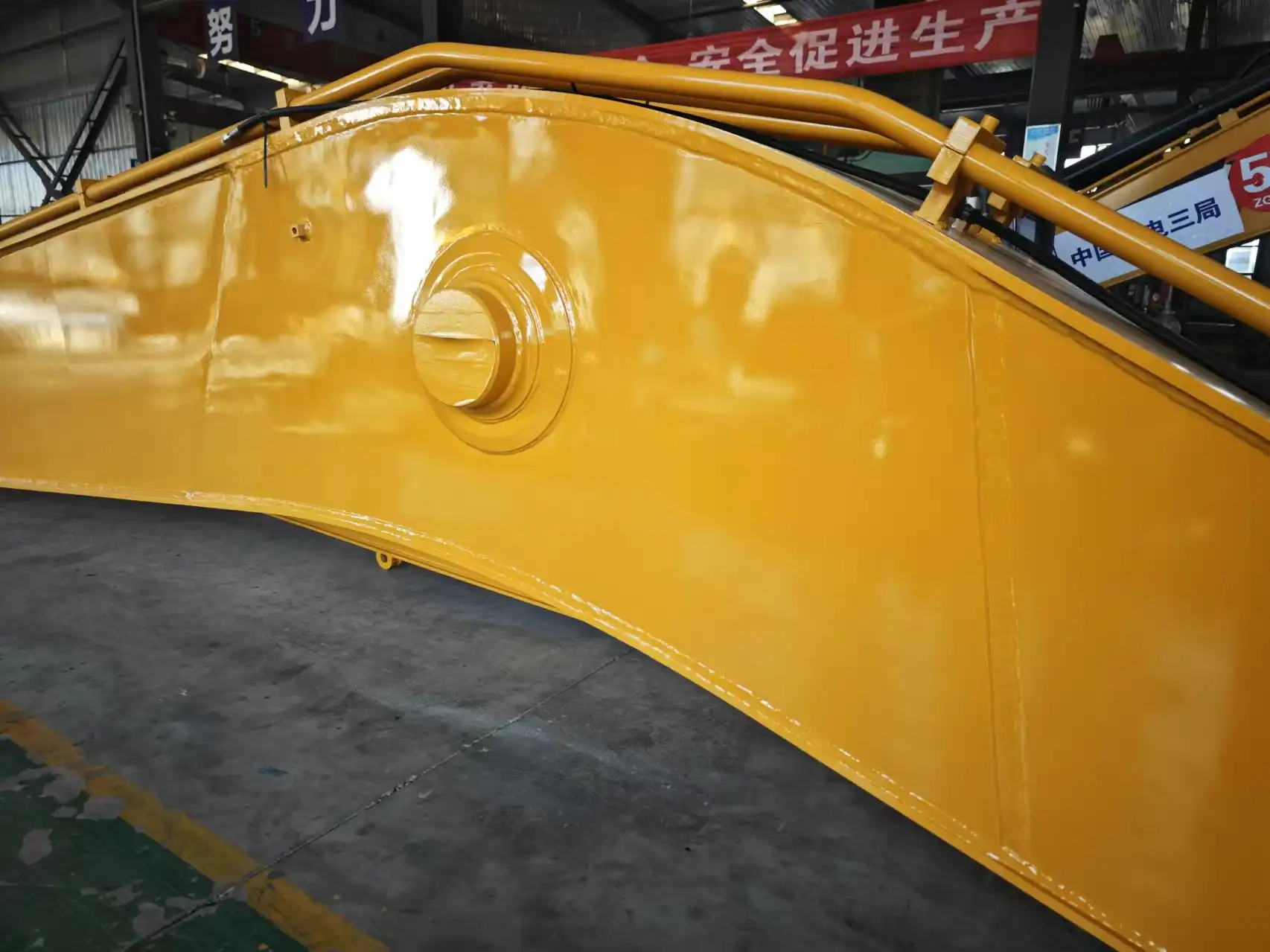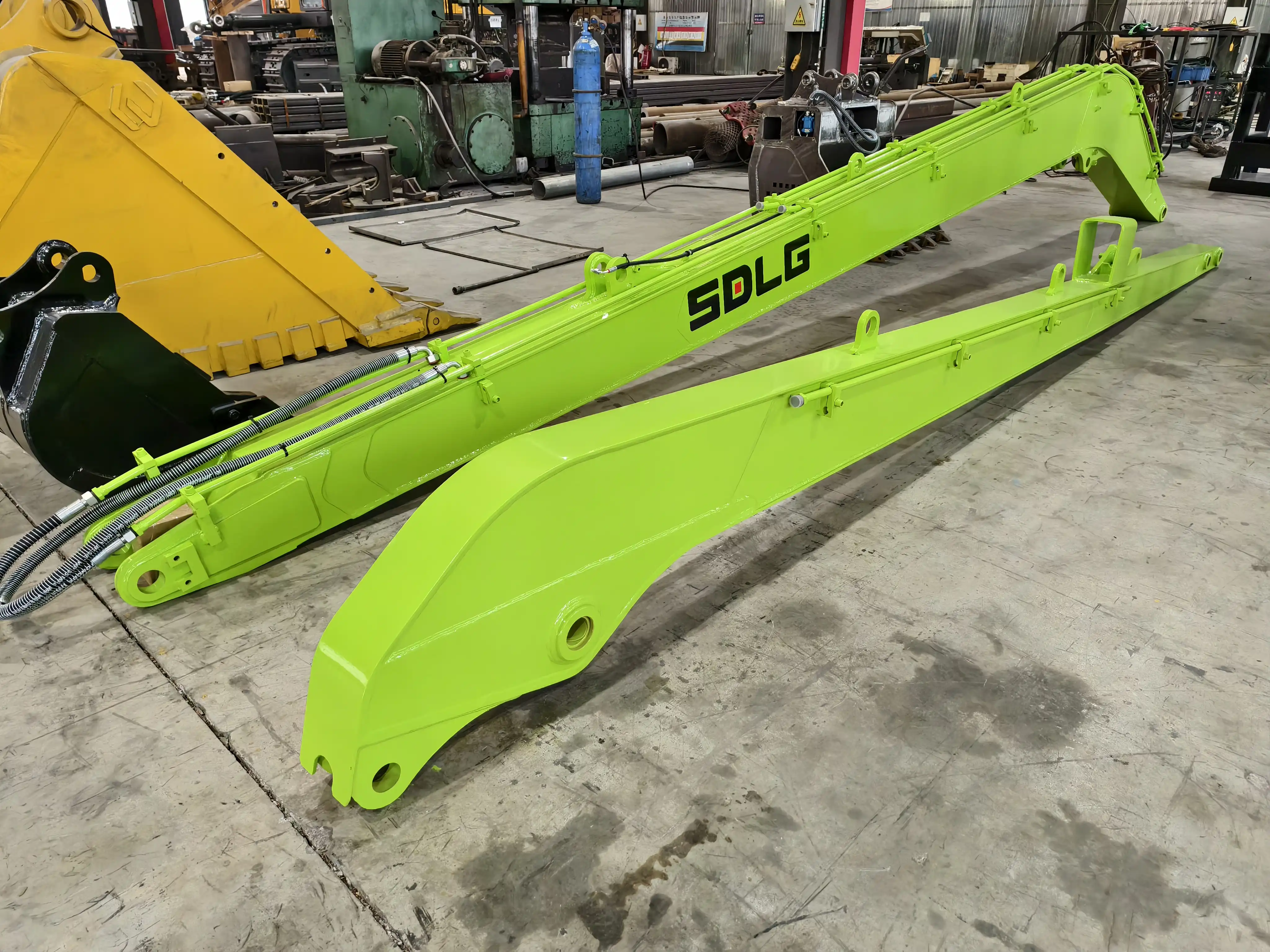What are excavator booms made of?
Excavator booms are primarily made of high-strength low-alloy steel, specifically Q355 and Q460 grades, which provide the perfect balance of strength, durability, and weight management required for heavy-duty applications. These robust components form the backbone of modern excavation equipment, particularly in excavators long reach boom designs, where material quality becomes even more critical. The extended reach capability, often stretching to 18 meters or beyond, demands materials that can withstand tremendous stress while maintaining structural integrity during operation.
When examining a long reach boom up close, you'll notice the precision engineering that goes into its construction. The primary boom structure consists of carefully fabricated steel plates welded together to form a box-section design. This isn't ordinary steel, though—manufacturers select specific alloys enhanced through sophisticated metallurgical processes. The material composition typically includes manganese, carbon, and small amounts of chromium, nickel, and molybdenum to enhance mechanical properties. This specialized composition allows the boom to handle the significant bending moments and torsional forces encountered during digging, lifting, and swinging operations without compromising safety or performance.
High-Strength Low-Alloy (HSLA) Steel: Q355/Q460

Material Composition and Properties
The foundation of any high-quality excavators long reach arm begins with the selection of appropriate steel grades. Q355 and Q460, designations from the Chinese GB standard, have become industry standards for heavy equipment manufacturing. The numbers indicate the minimum yield strength of the steel measured in megapascals (MPa). Q355 steel offers a yield strength of approximately 355 MPa, while Q460 provides enhanced strength at 460 MPa.
What makes these steels particularly suitable for excavator components is their carefully balanced chemical composition. Typical Q355 steel contains 0.20% carbon, 1.0-1.6% manganese, 0.55% silicon, and trace amounts of phosphorus and sulfur. The Q460 variant generally contains similar elements but with slightly adjusted ratios to achieve higher strength characteristics. This precise formulation creates materials that exhibit excellent toughness-to-weight ratios, critical for extended reach applications where every kilogram matters.
Manufacturing engineers at companies like Tiannuo Machinery understand that material selection represents a careful balancing act. While higher strength steels might seem preferable, they must consider factors beyond mere strength numbers, including:
①Weldability and fabrication ease
②Resistance to crack propagation
③Fatigue performance under cyclical loading
④Cost considerations and material availability
⑤Corrosion resistance in varied working environments
The preference for Q355 and Q460 steels stems from their excellent compromise between these competing factors, providing reliable performance across diverse operating conditions.
Manufacturing Process
Converting raw steel into a finished excavators long reach boom involves sophisticated manufacturing processes that preserve and enhance the material's inherent properties. The journey typically begins with large steel plates of specific thicknesses—ranging from 8mm to 25mm depending on the component's structural requirements.
These plates undergo precision cutting using computer numerical control (CNC) plasma or laser cutting systems, which ensure dimensional accuracy crucial for subsequent assembly. The cut pieces then move to forming stations where hydraulic presses bend them into the characteristic shapes needed for boom sections. This cold-forming process must be carefully controlled to avoid introducing stress concentrations that could become failure points during service.
The most critical stage comes during the welding phase. Manufacturers employ specialized welding procedures that account for the metallurgical characteristics of HSLA steels. Multi-pass welding techniques with strict heat input control prevent issues like hydrogen embrittlement or excessive hardening in the heat-affected zones. Premium fabricators utilize:
①Flux-cored arc welding for deep penetration at critical joints
②Submerged arc welding for longitudinal seams
③Gas metal arc welding for attachments and brackets
④Comprehensive non-destructive testing, including ultrasonic and magnetic particle inspections
Tiannuo's approach to boom manufacturing emphasizes these quality-focused processes, particularly for their extended reach models designed for specialized applications in railway maintenance and construction projects.
Stress Distribution Analysis
Engineering an excavators long reach boom requires a sophisticated understanding of how forces are distributed throughout the structure during operation. Modern design methodologies employ finite element analysis (FEA) to identify stress concentrations and optimize material usage accordingly.
The boom's box-section design isn't uniform throughout its length; strategic variations in plate thickness respond directly to anticipated stress patterns. Areas near pivot points and hydraulic cylinder mounts typically incorporate thicker material or additional reinforcement plates. This variable-thickness approach optimizes the weight-to-strength ratio while ensuring safety margins remain intact.
For extended reach applications, the stress profile becomes even more complex. The boom experiences:
①Primary bending moments that increase dramatically with reach distance
②Torsional forces during slewing operations
③Dynamic shock loading occurs when the bucket engages with material
④Fatigue-inducing cyclic loading during repetitive operations
Engineers must account for all these factors when determining material specifications. The Q355/Q460 steel selections provide the necessary mechanical properties to withstand these complex loading patterns while maintaining the structural integrity essential for safe operation, particularly in demanding environments like railway construction sites or mining operations.
Heat Treatment

Normalizing and Stress Relief
Heat treatment processes play a vital role in optimizing the performance characteristics of excavator boom materials. After fabrication, many excavators long reach boom attachment components undergo normalizing, a heat treatment process where the steel is heated to approximately 900°C and then allowed to cool in still air. This process refines the grain structure, relieves internal stresses from manufacturing, and creates a more uniform microstructure throughout the component.
Particularly for welded structures like excavator booms, stress relief treatments become essential. The intense localized heating during welding creates residual stresses that, if left untreated, could lead to premature failure or distortion over time. Stress relief typically involves heating the entire structure to a temperature of 550-650°C, holding it at this temperature for a calculated period based on material thickness, and then cooling it slowly. This process:
①Reduces residual stress without significantly altering the material's microstructure
②Minimizes the risk of stress corrosion cracking
③Improves dimensional stability during service
④Enhances fatigue resistance in cyclically loaded components
For Tiannuo's 18-meter long reach booms, proper heat treatment becomes even more critical due to the exceptional leverage forces these components experience during operation.
Quenching and Tempering
While not applied to the entire boom structure, certain high-stress components within the boom assembly may undergo quenching and tempering treatments. This process involves heating the steel to its austenizing temperature (typically 845-870°C), rapidly cooling it in oil or water (quenching), followed by reheating to a lower temperature (tempering).
The result is a material with enhanced hardness, wear resistance, and strength, ideal for components like pin connections, bushings, and cylinder mounting points. The precise tempering temperature determines the final balance between hardness and toughness, allowing engineers to customize material properties for specific applications.
Modern excavator manufacturers often employ selective heat treatment, focusing these more intensive processes on the components that will experience the highest wear or stress concentration. This targeted approach optimizes performance while controlling manufacturing costs and production complexity.
Mechanical Property Enhancement
The ultimate goal of heat treatment in excavator boom manufacturing is to enhance specific mechanical properties that directly impact performance and longevity. When properly executed, these thermal processes can significantly improve:
①Yield and tensile strength
②Impact resistance and toughness
③Fatigue life under cyclic loading
④Wear resistance at articulation points
Dimensional stability during operation
For excavators long reach boom applications, these enhancements become particularly valuable. The extended reach creates magnified force moments that test the material's limits during daily operation. Railway maintenance tasks, demolition work, and heavy construction applications all impose severe demands on these components.
Heat treatment represents the critical link between material selection and actual field performance. Even the highest quality base materials cannot achieve their full potential without proper thermal processing. Tiannuo's manufacturing protocols incorporate these heat treatment best practices to ensure their extended reach booms meet the rigorous demands of customers in specialized sectors like railway construction and maintenance.
Surface Treatments

Protective Coatings
The longevity of an excavators long reach boom depends significantly on its ability to withstand harsh environmental conditions. While the base material provides structural integrity, protective coatings defend against corrosion, abrasion, and UV degradation that would otherwise gradually compromise the component.
Modern excavator manufacturers implement multi-layer coating systems typically consisting of:
①Surface preparation through grit blasting or shot blasting to create an optimal profile for coating adhesion
②Zinc-rich primer application that provides galvanic protection
③High-build epoxy intermediate coat for barrier protection
④Polyurethane or polysiloxane topcoat for UV resistance and aesthetic finish
These systems offer comprehensive protection against diverse threats including:
①Atmospheric corrosion from moisture and pollutants
②Chemical exposure from industrial environments
③Abrasion from soil and rock contact
④UV degradation that can compromise coating integrity
For specialized applications like railway maintenance, where equipment may be exposed to unique environmental challenges such as electrical conductivity concerns near electrified rails, manufacturers like Tiannuo develop custom coating specifications to address these specific requirements.
Wear-Resistant Treatments
Areas of the boom that experience direct contact with abrasive materials require additional protection beyond standard paint systems. Modern excavator booms incorporate several specialized wear-resistant treatments, particularly at the bucket attachment points and other high-wear zones.
These treatments may include:
①Hard-facing through weld overlay with specialized alloys
②Thermal spray coatings using tungsten carbide or chromium oxide
③Nitriding or carburizing surface hardening treatments
④Detachable wear plates at critical contact points
The application of these treatments must balance wear protection with structural integrity considerations. Excessive hard-facing, for instance, can introduce undesirable heat-affected zones or residual stresses if not properly managed during application.
For excavators long reach boom designs, the wear pattern analysis becomes more complex due to the altered geometry and force distribution. Engineers must anticipate how the extended reach changes the interaction between the boom and its working environment, adjusting wear protection strategies accordingly.
FAQ
①What makes long reach excavator booms different from standard booms?
Long reach excavator booms are specifically engineered with extended dimensions that allow them to reach areas inaccessible to standard excavators. These specialized booms can extend to 18 meters or more, requiring enhanced material specifications and design considerations to manage the increased stress from the extended leverage. The structural engineering must account for significantly higher bending moments and torsional forces while maintaining operational stability.
②How often should excavator booms be inspected for structural integrity?
Professional inspection of excavator booms should occur at least annually, with more frequent visual checks recommended as part of regular maintenance routines. Operators should conduct daily visual inspections of critical areas like welds, pins, and cylinder mounts. For excavators long reach boom applications, which experience higher stress levels, more rigorous inspection schedules may be appropriate, particularly when operating in demanding environments like demolition or heavy construction.
③Can damaged excavator booms be repaired rather than replaced?
Yes, damaged excavator booms can often be repaired depending on the nature and extent of the damage. Minor cracks or wear issues can be addressed through specialized welding procedures performed by certified technicians. However, structural failures in critical areas may necessitate component replacement to maintain safety standards. Any repair work should follow manufacturer specifications and may require post-repair heat treatment to restore material properties.

Contact Tiannuo Machinery
The construction of excavators ' long-reach boom components represents a sophisticated intersection of materials science, structural engineering, and manufacturing technology. The predominant use of high-strength low-alloy steels like Q355 and Q460 provides the essential foundation for these critical components, offering the necessary balance of strength, fabricability, and economic viability. The carefully engineered box-section design, with its strategically varied plate thicknesses, optimizes weight while maintaining the structural integrity needed for safe operation.
Beyond the base material selection, the comprehensive heat treatment protocols enhance the boom's mechanical properties, ensuring it can withstand the complex loading patterns encountered during diverse applications in railway construction, mining, and heavy landscaping. The surface treatment systems, including advanced coating technologies and wear-resistant applications, protect this structural investment against environmental degradation, significantly extending service life under challenging conditions.
For operations requiring specialized equipment capabilities, particularly those involving extended reach requirements, understanding these material considerations becomes even more critical. The amplified stress patterns in long-reach configurations demand exceptional material quality and processing precision to maintain both performance and safety standards. Tiannuo Machinery's commitment to these engineering fundamentals is evident in their comprehensive product line, designed specifically for these demanding applications.
If you're interested in learning more about our excavators long reach boom products, including our 18-meter reach models designed for specialized applications, please contact us at arm@stnd-machinery.com. Our engineering team can provide detailed specifications tailored to your specific operational requirements, ensuring you obtain equipment that delivers optimal performance for your unique application needs.

References
Journal of Materials Engineering and Performance, "Microstructure and Properties of Q355 and Q460 Steel Weldments for Heavy Equipment Applications," Volume 29, Issue 8.
International Journal of Fatigue, "Fatigue Life Assessment of Excavator Boom Structures Under Variable Amplitude Loading," Volume 42.
Materials Science and Engineering, "Effects of Heat Treatment on Mechanical Properties of High-Strength Low-Alloy Steels for Construction Equipment," Volume 528.
Construction and Building Materials, "Corrosion Protection Systems for Extended Service Life in Heavy Construction Equipment," Volume 145.
Journal of Construction Engineering and Management, "Material Selection Criteria for Long-Reach Excavator Components in Heavy Civil Engineering Applications," Volume 147.
About Author: Arm
Arm is a leading expert in the field of specialized construction and railway maintenance equipment, working at Tiannuo Company.

